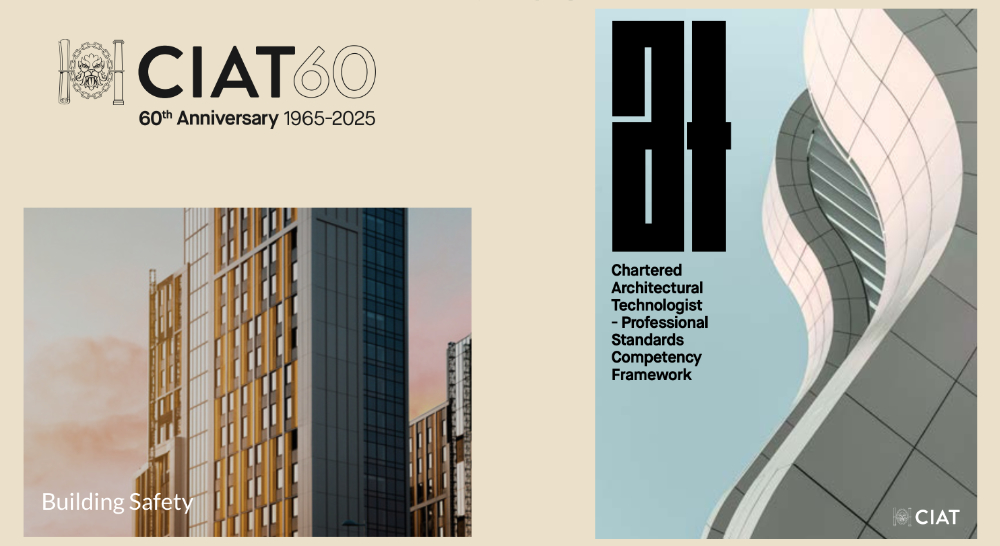New Chartered Architectural Technologist Professional Standards Competency Framework
The 2019 Professional Standards Framework (PSF), which provides information and guidance on the Educational, Practice and Professional standards for those seeking to qualify as Chartered Architectural Technologists, has now been phased out. The PSF has been superseded by the Professional Standards Competency Framework (PSCF). Professional assessment applications cross referenced against the PSCF will be accepted from 1 May 2025.
The CIAT Qualifying in Architectural Technology films provide insight and details on the requirements to qualify via the Professional Assessment. These can be viewed here and here. The phase out only affects Associates and Affiliates who were planning to submit a Professional Assessment application by 30 April 2025.
The Professional Standards Competency Framework (PSCF), which outlines the standards and competencies to qualify as a Chartered Architectural Technologist, was published on 1 May 2025.
These standards and competencies are defined within:
- Stage 1 – Educational Standards,
- Stage 2 – Practice Standards
- Stage 3 – Professional Standards
The framework underwent a periodic review following the revision of the Quality Assurance Agency Subject Benchmark Statement for Architectural Technology, which was published in 2022. It emphasises fire and health and safety, as well as materials, building performance and regulations. In addition to this, ethics, behaviour, professional conduct and CPD have been amplified in the document.
The title of the PSCF was also modified to indicate that it assesses the competence of applicants. These are assessed at a threshold level with the expectation that Chartered Architectural Technologists will continue to learn and advance in their career, thus further improving their capabilities.
Chartered Architectural Technologist - Professional Standards Competency Framework
The review began in spring 2023 with the support of a Review Group comprising of Honorary Fellows, Fellows, Chartered Members, Associates, Affiliates from varying spheres of the profession, in academia and industry, based in the UK and internationally.
“It is a real testament to the strength of our membership when you see initiatives like this come together,” said Usman Yaqub FCIAT, President-Elect of CIAT.
Associates and Affiliates have been notified of the phase out process to qualify under the 2019 PSF through the Professional Assessment qualifying process which ends on 30 April 2025. Anyone wishing to qualify from 1 May 2025 must meet the standards outlined in the PSCF.
“The new framework holds great importance for CIAT, Architectural Technology, and Architectural Technologists,” said Paul Laycock MCIAT, Vice-President Education & Chair of Moderators. “This is not just a guideline, but a transformative tool that will ensure the profession evolves to meet future demands around sustainability, technical innovation and ethical considerations. It reaffirms the importance of maintaining high standards, of encouraging personal and professional growth, and of ensuring Architectural Technology remains at the forefront of construction and design in the built environment.”
Professor Sam Allwinkle PPBIAT FCIAT, Chair of Education Board, agreed, saying, “The 2025 PSCF is a significant and important reference document for CIAT, Architectural Technology and Architectural Technologists and I am confident that these standards will help challenge, change and drive forward our profession in the next decade.” An external facing PSCF is currently in development, ready to be used to promote the profession and discipline.
If you would like further details on the PSCF or the 2019 PSF phase out, contact membership@ciat.global
This article appears in the AT Journal Spring issue 2025 as "Publication of new Chartered Architectural Technologist Professional Standards Competency Framework' and was written by James Banks CMGr FCMI, Head of Membership.
--CIAT
[edit] Related articles on Designing Buildings.
- 2022 changes to fire safety guidance and building regulations.
- Advice for External Wall Insulation (EWI) systems with a render or brick-slip finish.
- AT Building Safety Hub.
- BS 8414 Fire performance of external cladding systems.
- BS 9991:2015 Fire safety in the design, management and use of residential buildings. Code of practice.
- BS 9999: Code of practice for fire safety in the design, management and use of buildings.
- Building a safer future: an implementation plan.
- Building Safety Act.
- Building Safety Charter.
- Building Safety Fund.
- Building safety in Wales.
- Building Safety Regulator.
- CIAT articles.
- CIAT publishes Principal Designer Competency Framework.
- Fire performance of external thermal insulation for walls of multistorey buildings, third edition (BR 135).
- Fire Safety Act.
- Framework.
- Golden thread guidance to be published by BSA.
- Government response to the Building a Safer Future consultation.
- Grenfell Tower fire.
- Hackitt review of the building regulations and fire safety, final report.
- HPL cladding.
- Independent review of the building regulations and fire safety.
- Independent review of the construction products testing regime.
- Joint Competent Authority.
- Non-ACM cladding.
- Raising the bar.
- Reform of building safety standards.
- Setting the bar.
- The Regulatory Reform (Fire Safety) Order 2005.
- The CIAT principal designer register.
Featured articles and news
Design and construction industry podcasts
Professional development, practice, the pandemic, platforms and podcasts. Have we missed anything?
C20 Society; Buildings at Risk List 2025
10 more buildings published with updates on the past decade of buildings featured.
Boiler Upgrade Scheme and certifications consultation
Summary of government consultation, closing 11 June 2025.
Deputy editor of AT, Tim Fraser, discusses the newly formed society with its current chair, Chris Halligan MCIAT.
Barratt Lo-E passivhaus standard homes planned enmasse
With an initial 728 Lo-E homes across two sites and many more planned for the future.
Government urged to uphold Warm Homes commitment
ECA and industry bodies write to Government concerning its 13.2 billion Warm Homes manifesto commitment.
From project managers to rising stars, sustainability pioneers and more.
Places of Worship in Britain and Ireland, 1929-1990. Book review.
The emancipation of women in art.
Call for independent National Grenfell oversight mechanism
MHCLG share findings of Building Safety Inquiry in letter to Secretary of State and Minister for Building Safety.
The Architectural Technology Awards
AT Awards now open for this the sixth decade of CIAT.
50th Golden anniversary ECA Edmundson awards
Deadline for submissions Friday 30 May 2025.
The benefits of precast, off-site foundation systems
Top ten benefits of this notable innovation.
Encouraging individuals to take action saving water at home, work, and in their communities.
Takes a community to support mental health and wellbeing
The why of becoming a Mental Health Instructor explained.
Mental health awareness week 13-18 May
The theme is communities, they can provide a sense of belonging, safety, support in hard times, and a sense purpose.
Mental health support on the rise but workers still struggling
CIOB Understanding Mental Health in the Built Environment 2025 shows.
Design and construction material libraries
Material, sample, product or detail libraries a key component of any architectural design practice.


























